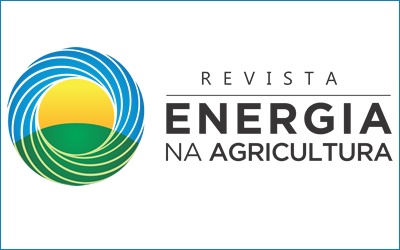COBERTURA DAS FOLHAS DE SOJA UTILIZANDO PONTAS DE PULVERIZAÇÃO COM DIFERENTES FORMATOS DOS JATOS*
DOI:
https://doi.org/10.17224/EnergAgric.2022v37n2p12-21Resumo
COBERTURA DAS FOLHAS DE SOJA UTILIZANDO PONTAS DE PULVERIZAÇÃO COM DIFERENTES FORMATOS DOS JATOS*
ARIANNE MONIZ CHECHETTO1, ULISSES ROCHA ANTUNIASSI2, RODOLFO GLAUBER CHECHETTO3, VITOR CARVALHO RIBEIRO DE ARAÚJO4, FERNANDO KASSIS CARVALHO3
* Artigo extraído da dissertação do primeiro autor.
1 Engenheira Agrônoma, Doutoranda no Programa de Energia na Agricultura, Faculdade de Ciências Agronômicas, UNESP, Botucatu/SP - Brasil, a.moniz@unesp.br
2 Engenheiro Agrônomo, Professor Titular, Departamento de Engenharia Rural, Faculdade de Ciências Agronômicas, UNESP, Botucatu/SP, ulisse.antuniassi@unesp.br
3 Engenheiro Agrônomo, Pesquisador da AgroEfetiva, Botucatu/SP – Brasil.
4 Engenheiro Agrônomo, Doutorando no Programa de Energia na Agricultura, Faculdade de Ciências Agronômicas, UNESP, Botucatu/SP - Brasil
RESUMO: O objetivo dessa pesquisa foi avaliar a interação entre os formatos dos jatos de pulverização e os volumes de calda, na cobertura nas folhas de soja. Os tratamentos foram compostos por três pontas de pulverização com diferentes formatos dos jatos (jato plano, jato plano duplo e jato plano angulado) e dois volumes de caldas (100 e 200 L ha-1). A análise de cobertura foi realizada através da avaliação visual, comparando cada folha com uma escala de notas, em sala escura com iluminação fluorescente. No extrato superior, ocorreu 27,59% a mais de cobertura no volume de calda de 200 L ha-1, comparado com 100 L ha-1 e entre os formatos dos jatos, não houve diferença significativa. No extrato médio/inferior, ocorreu 52,32% a mais de cobertura no volume de calda de 200 L ha-1, comparado com o 100 L ha-1 e entre os formatos dos jatos não houve diferença significativa. Em aplicação de fungicidas no início do florescimento da soja, o formato do jato de pulverização não alterou a cobertura do alvo e o aumento do volume de calda de 100 para 200 L ha-1 aumentou a cobertura do alvo, para ambos os extratos analisados.
Palavras-chaves: tecnologia de aplicação, gotas médias, fungicida.
COVERAGE IN SOYBEAN LEAVES WITH DIFFERENT SPRAY NOZZLES
ABSTRACT: The aim of this research was to evaluate interaction between the spray nozzles shape and the application volume rate, in the coverage in soybean leaves. The treatments consisted of three spray nozzles (pre-orifice low drift flat fan, pre-orifice low drift double flat fan and angled flat fan) and two application volumes rates (100 and 200 L ha-1). The analysis of coverage was perform through the visual evaluation, comparing each leaf with a scale of grades, in a dark room with fluorescent lighting. In the upper portion of canopy had 27.59% more coverage in the 200 L ha-1 than 100 L ha-1. There were no significant difference between the nozzles, in the upper portion. In the medium/lower portion of canopy, the application volumes rates of 200 L ha-1 had 52.32% more coverage than 100 L ha-1 and there were no significant difference between the nozzles. When applying fungicides at the beginning of soybean flowering, the shape of spray nozzles does not change the leaf coverage in any canopy portion. The change in application volume rates from 100 to 200 L ha-1 increased the leaf coverage, for both portions of the canopy analyzed.
Keywords: application technology, medium droplets, fungicide.
Publicado
Como Citar
Edição
Seção
Licença
Copyright (c) 2023 ENERGIA NA AGRICULTURA

Este trabalho está licenciado sob uma licença Creative Commons Attribution-NonCommercial-NoDerivatives 4.0 International License.
Esta revista proporciona acesso publico a todo seu conteúdo, seguindo o princípio que tornar gratuito o acesso a pesquisas gera um maior intercâmbio global de conhecimento. Tal acesso está associado a um crescimento da leitura e citação do trabalho de um autor. Para maiores informações sobre esta abordagem, visite Public Knowledge Project, projeto que desenvolveu este sistema para melhorar a qualidade acadêmica e pública da pesquisa, distribuindo o OJS assim como outros software de apoio ao sistema de publicação de acesso público a fontes acadêmicas.





